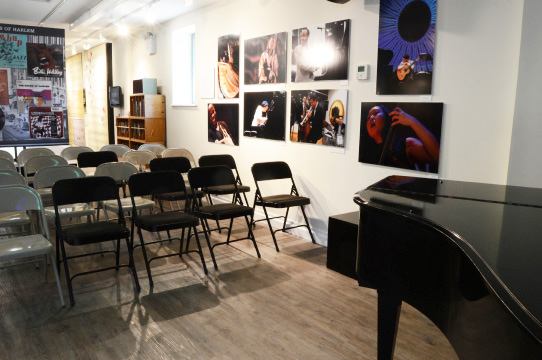Past Events
Music on the Brain: Like Musical Minds w/ Helen Sung
Music on the Brain is a collaboration between the National Jazz Museum in Harlem and Columbia University’s Zuckerman Institute.
Helen Sung
Helen Sung is an acclaimed pianist/composer. Winner of a 2021 Guggenheim Fellowship, she has served on the faculties of the Juilliard School, Berklee College of Music, and Columbia University, where she was the inaugural jazz artist-in-residence at the Zuckerman Mind Brain Behavior Institute. Based in New York City, Helen maintains a schedule of performing/touring, teaching, and recording: her latest project Quartet+, made possible by a NYFA NYC Women’s Fund grant, was released on Sunnyside Records in September 2021. In addition to her own band, Helen has performed with such luminaries as Clark Terry, Ron Carter, Wayne Shorter, Regina Carter, Terri Lyne Carrington, and fine ensembles including the Mingus Big Band and Cecile McLorin Salvant’s Ogresse. Helen is a Steinway Artist.
Dr. Michael Shadlen
When Michael Shadlen, MD, PhD, was a neurology resident, he encountered a lot of patients high on PCP. Their eyes darted around uncontrollably, their visual systems unable to tally up previous eye movements to calculate their current position. Patients also exhibited confusion, leading Shadlen to hypothesize that, at its core, confusion results from an inability of the brain to integrate individual bits of information and piece them together into a complete picture. For these patients, the past has no bearing on the present and everything is new and threatening. This idea has guided his research as a principal investigator at Columbia’s Mortimer B. Zuckerman Mind Brain Behavior Institute, leading to new insights about how nerve cells in the brain, known as neurons, use experience to make decisions.
In his lab, Dr. Shadlen studies how we turn visual signals into behavior. He focuses on the brain’s parietal cortex, a region that acts as a go-between — linking areas that take in sensory input to those that prepare the body to act. People with damage to the parietal cortex exhibit trouble with various skills, from understanding numbers to knowing what objects are for, “so the parietal cortex seems like a great place to look for the seeds of higher brain function in general,” Dr. Shadlen says.
In a typical experiment, an animal will view a video screen and have to decide between looking at a red or a green spot in hopes of a reward. A series of learned clues — abstract shapes such as squares and triangles — appear on the screen suggesting one spot or the other is more likely to pay off. As the animal contemplates its decision, Dr. Shadlen records the activity of individual neurons.
He likens a neuron’s behavior as it weighs the evidence to the cracking of the German Enigma machine in World War II: “The neurons are effectively doing math as they change their firing rate — calculating the kind of quantities a statistician would assemble to decide between one hypothesis or another.” In everyday life, these decisions might pertain to what word to say next in a conversation, whether to carry an umbrella, or whom to marry.
He’s also found that single neurons can keep track of time for up to several seconds. After training an animal by presenting two flashes separated by a certain interval, he observed that these same parietal neurons will increase activity when they “expect” the second flash to arrive. Such anticipation, Dr. Shadlen says, allows us to wait until the right time to do things, and to predict and resolve our expectations. Anticipation, persistence and deliberation are examples of “freedom from the immediacy of the sensory world and the motor world.”
Sometimes Dr. Shadlen plays curious listeners audio recordings of individual neurons as they cogitate. “People are intrigued by the idea that they’re witnessing what it is that constitutes an evolving thought process in the brain,” he says.
Dr. Shadlen started his career as a physician but was frustrated by how little he could do to help people with brain problems. There were so many gaps in what we knew about the brain, he recalls, that he was drawn to the lab. He hopes his work to decipher the fundamental components of cognition will one day help treat people with disorders ranging from schizophrenia to autism to dementia.
He also wants to understand the general mechanisms of thought. “My view is that advanced cognition, language, philosophizing, all the fancy stuff that we humans do — even consciousness for that matter — all use these same basic building blocks,” he says. And understanding those building blocks is the key to understanding everything else.

National Jazz Museum in Harlem

